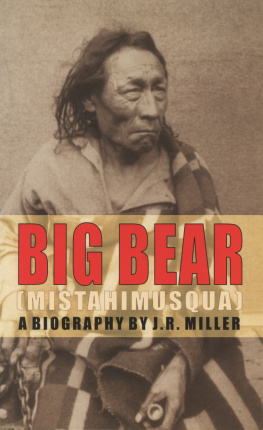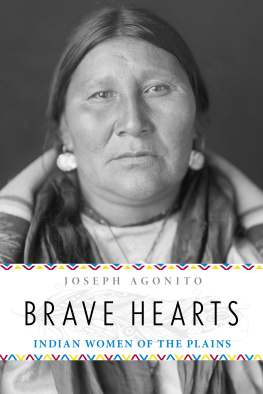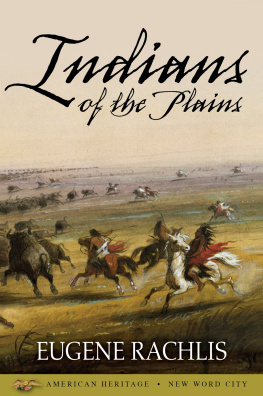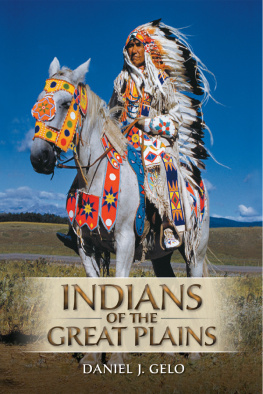Big Bear
(MISTAHIMUSQUA)
J.R. Miller
Canadian Biography Series
ECW PRESS
ACKNOWLEDGEMENTS
Archivists and librarians at the National Archives of Canada, Saskatchewan Archives Board, and Glenbow Archives gave advice on sources and illustrations in their usual, efficient manner. Dr. Robert S. Allen, an acknowledged authority on Native history, generously assisted with information on his own published work on Big Bear and research notes on the North West Mounted Police that he had made. My colleague Dr. Bill Waiser answered innumerable questions and provided copies of several key sources. I am grateful to all these people.
The Office of Research Services of the University of Saskatchewan, directed by Dr. Michael Owen, provided assistance from the Publications Fund to procure copies of some of the archival photographs and to prepare the map used in this book. The map was skillfully drawn by Keith Bigelow, cartographic technician, Department of Geography, University of Saskatchewan.
Dallas Harrison provided expert and efficient copyediting that improved the prose.
Finally and most importantly, I am, as usual, indebted to my wife, Mary, who not only considered queries and offered suggestions but also located and copied several primary sources for me.
This brief study of a key figure in both Cree and Canadian history is dedicated to the Plains peoples.
Photographs: Cover photo, National Archives of Canada, c 1873 ; frontispiece illustration, sketch by C.W. Jeffreys, National Archives of Canada, c 69930 ; illustration , map by Keith Bigelow, University of Saskatchewan; illustration , National Archives of Canada, PA 31615 ; illustration , National Archives of Canada, c 5181 ; illustration , National Archives of Canada, c 33472 ; illustration , National Archives of Canada, PA 118768 ; illustration , Royal Ontario Museum .., is used by permission of Royal Ontario Museum; illustration , sketch by Lt. Back, RN, Feb. 1820 , National Archives of Canada, c 33615 ; illustration , watercolour by A.J. Miller, 1867 , National Archives of Canada, c ; illustration , Canadian Illustrated News, Sept. 1871 , National Archives of Canada, c 56481 ; illustration , A.C. Mcintyre, after a sketch by M. Bastien in Canadian Illustrated News, Dec. 1876 , National Archives of Canada, c 64741 ; illustration , National Archives of Canada, c 70758 ; illustration , National Archives of Canada, c 18892 ; illustration , G.M. Dawson, June 1883 , National Archives of Canada, PA 50749 ; illustration , G.M. Dawson, June 1883 , National Archives of Canada, PA 50746 ; illustration , Illustrated War News, June 1885 , is used by permission of Glenbow Archives, NA 1353 -; illustration , Arthur DePatie, is used by permission of Glenbow Archives, NA 4154 -; illustration , T.B. Strange, is used by permission of Glenbow Archives, NA 1817 -; illustration , Canadian Pictorial and Illustrated War News, July 1885 , is used by permission of Glenbow Archives, NA 1480 -; illustration , Illustrated War News, is used by permission of Glenbow Archives, NA 1353 -; illustration , Fred A. Russell and Kalamazoo Public Library, Kalamazoo, MI, is used by permission of Glenbow Archives, NA -; illustration is used by permission of Glenbow Archives, NA -; illustration , C.B. Buell, is used by permission of Glenbow Archives, NA 3205 -; illustration , William Pearce, is used by permission of Glenbow Archives, NA -; illustration , Public Archives of Manitoba, is used by permission of Glenbow Archives, NA 1315 -; and illustration , Hall and Lowe and Public Archives of Manitoba, is used by permission of Glenbow Archives, NA 1315 -.

Big Bear as sketched by C.W. Jeffreys.
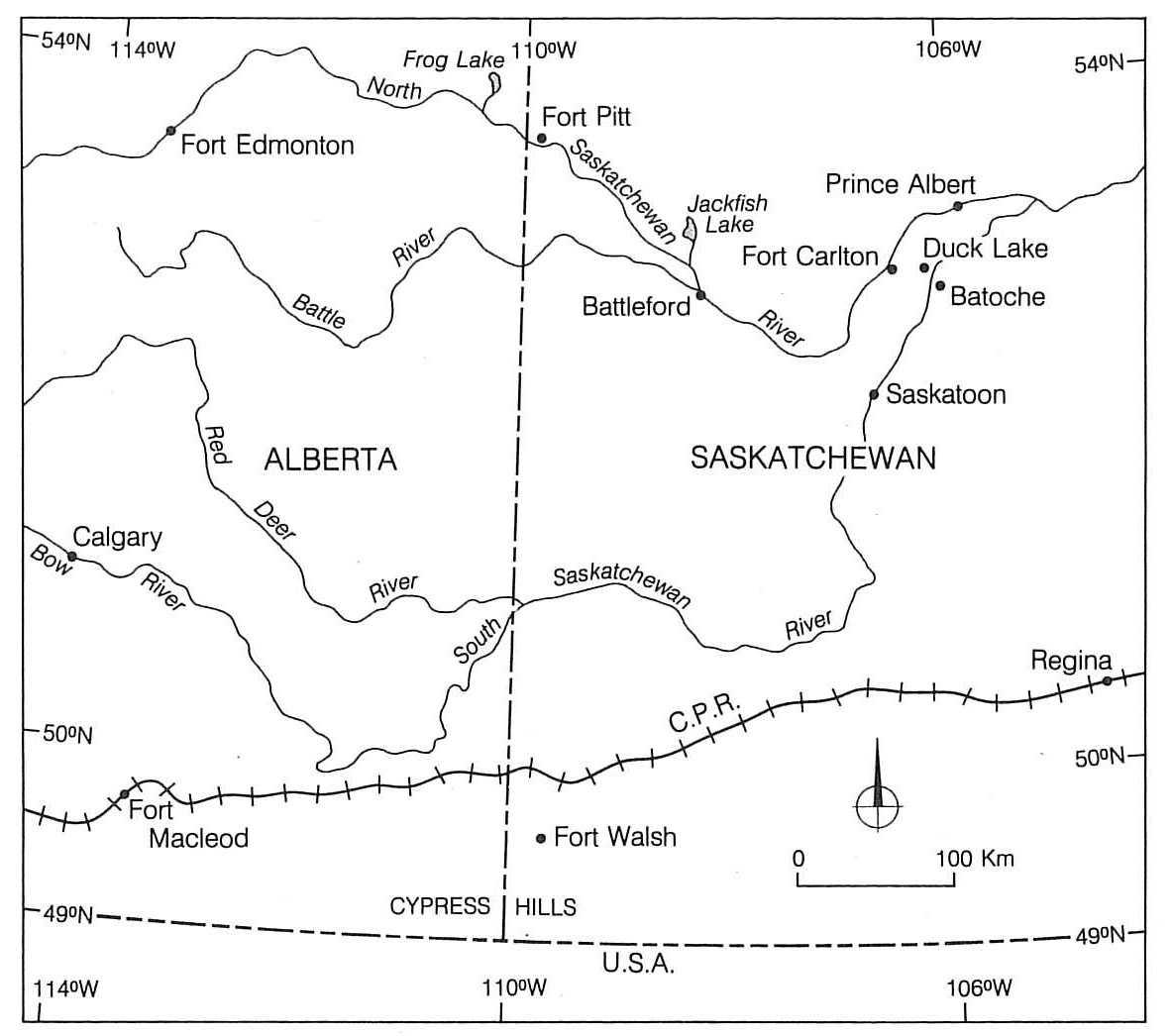
Big Bear's World.
AT JACKFISH LAKE
Some fifty kilometres north of the junction of the Battle and the North Saskatchewan Rivers, Jackfish Lake sparkles as the warm sun returns in the spring. Settled into the rolling, lightly wooded country that is typical of the prairie parkland region, it has long served as a rich source of fish, wood, and water for a succession of human populations, both Aboriginal and non-Native. The parkland appeals in the twentieth century to urban populations seeking outdoor recreation, occasionally as in the case of fishing and hunting parties and seasonally in the case of the middle-class families from Saskatoon and other places who relocate in the warm weather to cottages on Jackfish Lake. For those who cannot afford or do not favour cottage life, camping is available for trailers, mobile homes, and tents in Battleford Provincial Park, which touches one side of the lake. When campers, hunters, or cottagers make their way to Jackfish Lake, they quickly encounter several Native populations, some Mtis and some Cree, on reserves and in settlements in the region. Ironically, these groups are descendants of Aboriginal communities that, two centuries ago and more, treated Jackfish Lake in a way that is the mirror image of that of the non-Natives seeking recreation there today: For groups of Cree, Saulteaux, and even some Assiniboine and Dakota, the parkland region served as a home base, particularly during the harsh winter months when its wood and its shelter in the lee of hills and wooded slopes made it a haven, from which they ranged out at other times to hunt for food, to bargain with the strangers at their distant trading forts, and, all too often, to engage in raids and warfare against other Aboriginal groups.
Into this setting the man those strangers would call Big Bear was born in 1825 . Son of Black Powder, chief of a small band, and a woman whose name has not survived, to his own people he was known as Mistahimusqua. Black Powder was an Ojibwa (or Saulteaux), his wife either a Cree or an Ojibwa, and the band that he led a mixture of Cree and Ojibwa inhabiting a region dominated by Cree bands. Black Powder, or Mukatai in the language of his own people, was known for his audacity in making war, particularly against a traditional foe such as the Blackfoot, a confederacy of nations that lived far to the south-west. Mukatai was known to European traders as well, such as the Hudsons Bay employees at Carlton House on the North Saskatchewan.
In the Plains society into which Big Bear was born, it was not considered strange that his father led a mixed community of Cree and Ojibwa. Such a motley arrangement was by no means unusual in the 1820 s, no more than the ethnically mixed background of young Big Bear himself. The Cree, originally a woodlands people from the Canadian Shield country southwest of James Bay, had moved south and west from the early 1700 s onward in response to economic opportunities that arose in the fur trade. Pursuing trade opportunities over many decades, they had migrated in particular along the course of the Saskatchewan River into the heart of the prairie west.
As the Cree penetrated the plains, they came into contact, and sometimes into collision, with other groups. They often mixed in with Ojibwa, like themselves originally a woodlands hunting-and-gathering people who had moved west for economic reasons. In the west, the Ojibwa were often referred to as Saulteaux. (Increasing the possibility of misunderstanding, they were usually labelled Chippewa in the United States.) The Cree and Ojibwa also cooperated for trade purposes with the Assiniboine, a people of Siouan linguistic stock, who had entered the region from the south. The shifting commercial and military ties of Cree, Ojibwa, and Assiniboine were often necessary for defence against the large and well-organized nations of the Blackfoot Confederacy in what is now southern Alberta. Big Bears father, then, was one human link in a vast economic and military chain that joined a variety of Indigenous peoples, an extensive network that stretched from the foothills of the Rocky Mountains to the shores of James Bay and Hudson Bay, and even to the non-Native merchants and bankers of London across the ocean.

